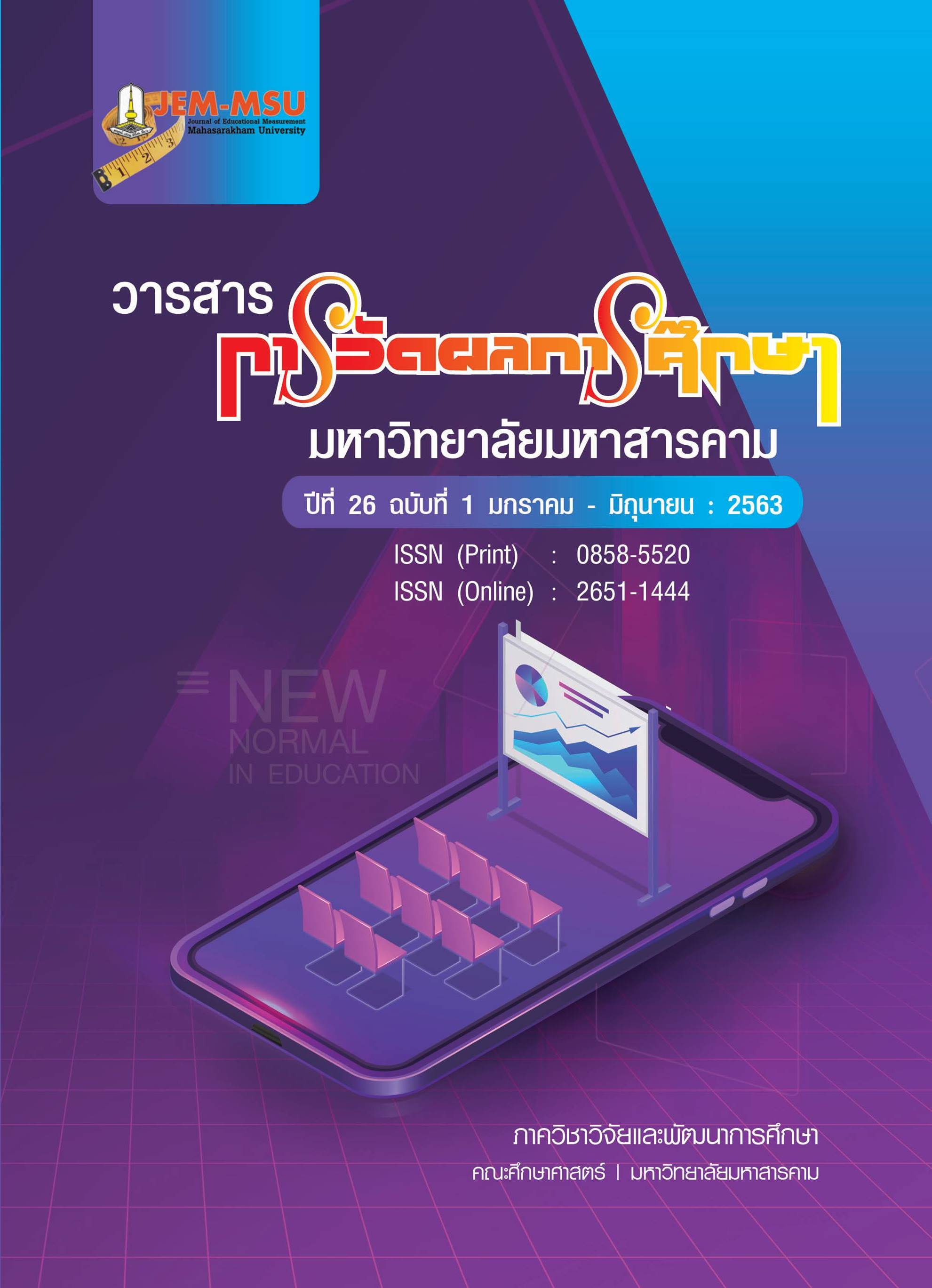Development of Ability of Thai Language Teachers in Designing Organizing for Learning by Using the Coaching and Mentoring Process to Elevate the Quality of Reading, Writing and Analytical thinking of Grade 5 Students of Banlaoh School, Phanom Dong Rak District, Surin Province
Main Article Content
Abstract
This research was a participatory action research. Its objectives were: (1) to assess the ability to design organizing for learning; (2) to compare the students’ achievements on the aspects of reading, writing and analytical thinking in the learning units that the teachers had designed their organizing for learning under coaching and mentoring; 3) to study satisfaction with the coaching and mentoring process. The target group consisted of the researcher and two co-researchers who were Thai language teachers. The research instruments were: an evaluation form for designing organizing for learning, a supervision record, a student achievement test and a satisfaction questionnaire. Data were analyzed by using descriptive statistics: the mean and standard deviation; and also inferential statistics: dependent samples t-test. The research results were as follows:
1) The ability of the Thai language teachers to design organizing for learning was at the good level in all of the 3 plans. ( = 4.20, S.D.
= 0.67; = 4.32, S.D.
= 0.68; = 4.34, S.D.
= 0.63 respectively);
2) The comparison of the students’ achievements on the aspects of reading, writing and analytical thinking in the learning units that the teachers had designed their organizing for learning revealed that the post-learning achievements of the 3 aspects were higher than the pre-learning achievements, with statistical significance at the level of .05;
3) The teachers were satisfied with the coaching and mentoring process at a high level ( = 4.31, S.D. = 0.70).
Article Details
The content and information contained in the published article in the Journal of Educational Measurement Mahasarakham University represent the opinions and responsibilities of the authors directly. The editorial board of the journal is not necessarily in agreement with or responsible for any of the content.
The articles, data, content, images, etc. that have been published in the Journal of Educational Measurement Mahasarakham University are copyrighted by the journal. If any individual or organization wishes to reproduce or perform any actions involving the entirety or any part of the content, they must obtain written permission from the Journal of Educational Measurement Mahasarakham University.
References
กรองทอง จิรเดชากุล. (2550). คู่มือการนิเทศภายในโรงเรียน. กรุงเทพฯ: ธารอักษร.
กระทรวงศึกษาธิการ. (2552). หลักสูตรแกนกลางการศึกษาขั้นพื้นฐาน พุทธศักราช 2551. กรุงเทพฯ : โรงพิมพ์ชุมนุมสหกรณ์การเกษตรแห่งประเทศไทย จำกัด.
คณะครุศาสตร์ มหาวิทยาลัยราชภัฏสุรินทร์. (2562). รายงานการสำรวจสภาพปัจจุบันด้านการอ่าน เขียนและคิดวิเคราะห์ของนักเรียนระดับการศึกษาขั้นพื้นฐาน จังหวัดสุรินทร์.
จิราภรณ์ ฤทธิชัย อนงค์ศิริ วิชาลัย และ ประพิณ ขอดแก้ว. (2558). การพัฒนาความสามารถด้านการอ่านเชิงวิเคราะห์ กลุ่มสาระการเรียนรู้ภาษาไทย ของนักเรียนชั้นประถมศึกษาปีที่ 5 โดยใช้เทคนิคการสอนแบบเลือกสรร. วารสารมหาวิทยาลัยราชภัฏลำปาง, 3(2), 26-37.
ชญาพิมพ์ อุสาโห. (2556). การพัฒนาครูโดยใช้กระบวนการสร้างระบบการชี้แนะและการเป็นพี่เลี้ยง. เอกสารประกอบการพัฒนาครูโดยใช้กระบวนการสร้างระบบการชี้แนะและการเป็นพี่เลี้ยง โครงการพัฒนาครู โดยใช้กระบวนการสร้างระบบการชี้แนะและการเป็นพี่เลี้ยง Coaching and Mentoring. กรุงเทพมหานคร: คณะครุศาสตร์ จุฬาลงกรณ์มหาวิทยาลัย.
ชญาพิมพ์ อุสาโห, เฉลียว บุรีภักดี และสุมาลี พงศ์ติยะไพบูลย์. (2556). รายงานการวิจัย การประเมิน โครงการและถอดบทเรียนจากโครงการพัฒนาครูโดยใช้กระบวนการระบบพี่เลี้ยง Coaching & Mentoring ของสำนักงานเขตพื้นที่มัธยมศึกษา เขต 10 นครปฐม : มหาวิทยาลัยศิลปากรและ มหาวิทยาลัยราชภัฏเพชรบุรี.
ชญาพิมพ์ อุสาโห, เฉลียว บุรีภักดี และสุมาลี พงศ์ติยะไพบูลย์. (2561). การพัฒนาครูมืออาชีพโดยใช้การวิจัยจากประสบการณ์การเรียนรู้อย่างต่อเนื่องด้วยการสร้างสรรค์คุณภาพวิชาการ. Veridian E-Journal Silpakorn University, 13(1), 1739-1759.
นรินทร์ สังข์รักษา, เฉลียว บุรีภักดี และ สุมาลี พงศ์ติยะไพบูลย์. (2556). ประเมินผลและถอดบทเรียนโครงการพัฒนาครูโดยใช้กระบวนการสร้างระบบพี่เลี้ยง. เพชรบุรี :สำนักงานเขตพื้นที่การศึกษามัธยมศึกษาเขต 10.
บุรีรัตน์ จินดาศรี. (2552). การพัฒนาทักษะในการอ่าน คิดวิเคราะห์ และเขียนภาษาไทย โดยใช้ สถานการณ์จำลอง สำหรับนักเรียนชั้นประถมศึกษาปีที่ 3 โรงเรียนในกลุ่มตำบลสระตะเคียน จังหวัดนครราชสีมา. หลักสูตรปริญญาศึกษาศาสตรมหาบัณฑิต แขนงวิชาหลักสูตรและการสอน คณะศึกษาศาสตร์ มหาวิทยาลัยสุโขทัยธรรมาธิราช.
ปรียาพร วงศ์อนุตรโรจน. (2548). การนิเทศการสอน. กรุงเทพฯ: ศูนย์สื่อเสริมกรุงเทพฯ.
ธารทิพย์ นรังศิยาและวรรณี แกมเกตุ. (2559).การวิเคราะห์โมเดลเชิงสาเหตุของความสำเร็จของการชี้แนะและ การเป็นพี่เลี้ยง. วารสารอิเล็กทรอนิคทางการศึกษา (OJED), 11(2), 235-250.
วิชัย วงษ์ใหญ่ และ มารุต พัฒผล. (2557).การโค้ชเพื่อการรู้คิด (Cognitive Coaching). พิมพ์ครั้งที่ 3. กรุงเทพฯ : จรัลสนิทวงศ์การพิมพ์.
วิจารณ์ พานิช. (2555). วิถีสร้างการเรียนรู้เพื่อศิษย์ในศตวรรษที่ 21. กรุงเทพฯ : มูลนิธิสดศรี-สฤษดิ์วงศ์.
วารุณี ลัภนโชคดี. (2560). รูปแบบการพัฒนาครูภาษาไทยโดยใช้กระบวนการสร้างระบบพี่เลี้ยง. วารสารวิชาการมหาวิทยาลัยราชภัฏภูเก็ต, 13(2),150-181.
สฎายุ ธีระวณิชตระกูล. (2553). การบริหารงานบุคคลทางการศึกษา (Educational personnel Management). ชลบุรี: โรงพิมพ์เก็ทกู๊ดครีเอชั่น.
สมเกียรติ ทานอก และคณะ. (2556). การพัฒนาครูโดยใช้กระบวนการสร้างระบบพี่เลี้ยง Coaching and Mentoring: คณะครุศาสตร์ มหาวิทยาลัยราชภัฏนครราชสีมา
สุวิทย์ มูลคำ. (2547). กลยุทธ์การสอนคิดวิเคราะห์. พิมพ์ครั้งที่ 2 .กรุงเทพฯ : ห้างหุ้นส่วนจำกัดภาพพิมพ์.
สำนักทดสอบทางการศึกษา. (2560). การทดสอบทางการศึกษาระดับชาติขั้นพื้นฐาน (O-NET) ปีการศึกษา 2559 และการยกระดับผลการทดสอบ.[ออนไลน์]. ได้จาก: http://bet.obec.go.th/index/wp-content/uploads/2016/12/1.pptx. [สืบค้น วันที่ 5 กรกฎาคม 2562].
สำนักงานคณะกรรมการการศึกษาขั้นพื้นฐาน. (2553).การเสริมสร้างประสิทธิภาพการจัดการเรียนเพื่อการ พัฒนาการเรียนรู้ของผู้เรียน: การนิเทศแบบให้คำชี้แนะ (coaching). [ออนไลน์]. ได้จาก: http://bet.obec.go.th/eqa/images/2010/subject_4.doc. [สืบค้น วันที่ 5 กรกฎาคม 2562].
สำนักงานคณะกรรมการการศึกษาขั้นพื้นฐาน. (2558).นโยบายสำนักงานคณะกรรมการการศึกษาขั้นพื้นฐานปีงบประมาณ 2558. [ออนไลน์]. ได้จาก : http://www.plan.obec.go.th/ewt_dl_link.php?nid=1424&filename=index [สืบค้น วันที่ 5 กรกฎาคม 2562].
สำนักงานเลขาธิการสภาการศึกษา. (2558).โครงการปฏิรูปการเรียนรู้สู่ผู้เรียน (พ.ศ. 2557-2560)“สะท้อนปัญหาและทางออก ตอบโจทย์ปฏิรูปการศึกษาไทย” . กรุงเทพมหานคร: 21 เซ็นจูรี่.
สำนักงานเลขาธิการสภาการศึกษา. (2561). การพัฒนาตัวชี้วัดประสิทธิภาพการจัดการเรียนรู้ของสถานศึกษาในระดับการศึกษาขั้นพื้นฐาน. กรุงเทพฯ : บริษัท พริกหวานกราฟฟิค จำกัด.
สำนักงานส่งเสริมสังคมแห่งการเรียนรู้และพัฒนาคุณภาพเยาวชน. (2557). การยกระดับคุณภาพครูไทยในศตวรรษที่ 21. กรุงเทพ ฯ:สำนักงานส่งเสริมสังคมแห่งการเรียนรู้และพัฒนาคุณภาพเยาวชน. (เอกสารประกอบการประชุมวิชาการ “อภิวัฒน์การเรียนรู้ .สู่จุดเปลี่ยน ประเทศไทย” ระหว่างวันที่ 6 - 8 พฤษภาคม 2557).
Carmel, R. & Paul, M. (2015).Mentoring and coaching in academia: Reflections on a mentoring/ coaching relationship. Policy Futures in Education,13(4), 479-491.
Davis, B., & Higdon, K. (2008). The effects of mentoring/induction support on beginning teachers' practices in early elementary classrooms (K-3). Journal of Research in Childhood Education,22 (3), 261-274.
Finnerty, G. & Collington, V. (2013). Practical coaching by mentors: Student midwives’ perceptions, Nurse Education in Practice, 13(6), 573-557.
Ingvarson, L., Meiers, M., & Beavis, A. (2005). Factors affecting the impact of professional development programs on teachers' knowledge, practice, student outcomes & efficacy. Retrieved from http://epaa.asu.edu/epaa/v13n10/.
Mohsen, T. & Dennick, R. (2011). Making Sense of Cronbach’s Alpha. International Journal of Medical Education, 2011(2), 53-55.
Rovinelli, R. J., & Hambleton, R. K. (1977). On the use of content specialists in the assessment of criterion-referenced test item validity. Dutch Journal of Educational Research, 2, 49-60.
Salvucci, S., Walter, E., Conley, V., Fink, S., & Saba, M. (1997). Measurement error studies at the National Center for Education Statistics (NCES). Washington D. C.: U. S. Department of Education.
Şeref, T. (2009).Misuses of KR-20 and Cronbach’s Alpha Reliability Coefficients. Education and Science, 34(152), 101-112.


